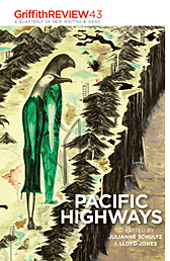Featured in

- Published 20140204
- ISBN: 9781922182241
- Extent: 300 pp
- Paperback (234 x 153mm), eBook

Already a subscriber? Sign in here
If you are an educator or student wishing to access content for study purposes please contact us at griffithreview@griffith.edu.au
Share article
More from author

Whale Survey, Raoul Island, with Rosemary Dobson
PoetryTwo poets on a headland, mid-survey might pause suddenly and say will this be your whale, or mine? Moving, accordingly, from one observation area to...
More from this edition

The beach
MemoirA SWEEP OF reef, two dashing freshwater rivers and a towering mountain, the bay of Apia, on the north coast of the island of...

The bottom of the pit
GR OnlineI ASSESSED OFATO in the visitor section of Silverwater jail in Sydney's western suburbs. Anxious, expectant relatives were directed, by stern guards, towards a...

Crime scenes
GR OnlineRANGIORA IS A small (population around twelve thousand) country town twenty-five kilometres north of Christchurch. It has an interesting town hall, which was damaged...